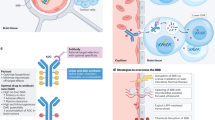Summary
Advances in surgical, radiation and chemotherapeutic techniques for the treatment of tumours of the CNS have not improved the prognosis of this type of cancer. Furthermore, the CNS represents a unique challenge to traditional chemotherapy because of the blood-brain barrier, the variety of tumours present within the CNS and heterogeneity within a given tumour type. Monoclonal antibody technology has provided a variety of new agents to explore as possible therapies for cancers. The use of antibodies to target isotopes, toxins, drugs or enzymes to brain tumours is currently being investigated.
A number of phenomena may affect the ability of these immunoconjugates to reach the target and their efficacy once at the target site. These include tumour susceptibility and accessibility, target antigen expression, the immune response of the patient and tumour heterogeneity. We conclude, based on our research and that of others, that immunoconjugates are effective against compartmentalised tumours in the CNS, and their primary role may be in the treatment of residual disease or in combined therapeutic regimens.
Similar content being viewed by others
References
Black PM. Brain tumours. N Engl J Med 1991; 324: 1471–6
Black PM. Brain tumours. N Engl J Med 1991; 324: 1555–64
Pizzo PA, Horowitz ME, Poplak DG, et al. Solid tumours in childhood. In: DeVita VT, Hellman S, Rosenberg SA, editors. Cancer principles and practice of oncology. Philadelphia: JB Lippincott, 1992: 1738–91
Blakey DC. Drug targeting with monoclonal antibodies: a review. Rev Oncology 1992; 5: 91–7
Byers VS, Baldwin RW. Therapeutic strategies with monoclonal antibodies and immunoconjugates. Immunology 1988; 65: 329–35
Frankel AE. Immunotoxin therapy of cancer. Oncology 1993; 7: 70–8
Eiklid K, Olsnes S, Pihl A. Entry of lethal doses of abrin, ricin, and modeccin into the cytosol of HeLa cells. Exp Cell Res 1980; 126: 321–6
Bagshawe KD, Springer CJ, Searle F, et al. A cytotoxic agent can be generated at cancer sites. Br J Cancer 1988; 58: 700–3
Johnson VG, Wrobel C, Wilson D, et al. Improved tumor specific immunotoxins in the treatment of CNS and leptomeningeal neoplasia. J Neurosurg 1989; 70: 240–8
Pietersz GA, McKenzie IFC. Antibody conjugates for the treatment of cancer. Immunol Rev 1992; 129: 57–80
Goldenberg DM. Monoclonal antibodies in cancer detection and therapy. Am J Med 1993; 94: 297–312
Kemshead JT, Papanastassiou V, Coakham HB, et al. Monoclonal antibodies in the treatment of central nervous system malignancies. Eur J Cancer 1992; 28: 511–3
Jones PT, Dear PH, Foote J, et al. Replacing the complimentarity-determining regions in a human antibody with those from the mouse. Nature 1986; 321: 522–5
Oi VT, Morrison SL. Chimeric antibodies. Biotechniques 1986; 4: 214–21
Reichmann L, Clark MR, Walmann H, et al. Reshaping antibodies for therapy. Nature 1988; 332: 323–7
Neuwelt EA, Balaban E, Diehl J, et al. Successful treatment of primary central nervous system lymphomas with chemotherapy after osmotic blood-brain barrier opening. Neurosurgery 1983; 12: 662–71
White S, Taetle R, Seligman PA, et al. Combinations of anti-transferrin receptor monoclonal antibodies inhibit tumor cell growth in vitro and in vivo: evidence of synergistic anti-proliferative effects. Cancer Res 1990; 50: 6295–301
Lashford LS, Davies AG, Richardson RB, et al. A pilot study of 131I monoclonal antibodies in the therapy of leptomeningeal tumors. Cancer 1988; 61: 857–68
Donelli MG, Zucchetti M, D’Incalci M. Do anticancer agents reach the tumor-target in the human brain? Cancer Chemother Pharmacol 1992; 30: 251–60
Zhu JH, Du Zw, Huang Q, et al. Drug-targeting by monoclonal antibody in neuro-oncology [abstract]. Childs Nerv Syst 1990; 6: 309
Papanastassiou V, Pizer BL, Coakham HB, et al. Treatment of recurrent and cystic malignant gliomas by a single intracavity injection of 131I monoclonal antibody: feasibility, pharmacokinetics and dosimetry. Br J Cancer 1993; 67: 144–51
Muraszko KM, Sung C, Walbridge, et al. Pharmacokinetics and toxicology of immunotoxins administered into the subarachnoid space in nonhuman primates and rodents. Cancer Res 1993; 53: 3752–7
Moseley RP, Davies AG, Richardson RB, et al. Intrathecal administration of 131I radiolabelled monoclonal antibody as a treatment of neoplastic meningitis. Br J Cancer 1990; 62: 637–42
Zovickian JG, Johnson VG, Youle RJ. Potent and specific killing of human malignant brain tumor cells by an anti-transferrin receptor antibody-ricin immunotoxin. J Neurosurg 1987; 66: 850–61
Hall WA, Fodstad O. Immunotoxins and central nervous system neoplasia. J Neurosurg 1992; 76: 1–12
Colombatti M, Bisconti M, Dell’Arciprete MA, et al. Sensitivity of human glioma cells to cytotoxic heteroconjugates. Int J Cancer 1988; 42: 441–8
Recht LD, Griffin TW, Raso V, et al. Potent cytotoxicity of an antihuman transferrin receptor-ricin A chain immunotoxin on human glioma cells in vitro. Cancer Res 1990; 50: 6696–700
Recht L, Torres CO, Smith TW, et al. Transferrin receptor in normal and neoplastic brain tissue: implications for brain tumor immunotherapy. J Neurosurg 1990; 72: 941–5
Martell LA, Agrawal A, Ross DA, et al. Efficacy of transferrin receptor-targeted immunotoxins in brain tumor cell lines and pediatric brain tumors. Cancer Res 1993; 53: 1348–53
Zovickian JG, Youle RJ. Efficacy of intrathecal immunotoxin therapy in an animal model of leptomeningeal neoplasia. J Neurosurg 1988; 68: 767–74
Urch CE, George AJT, Stevenson GT, et al. Intra-thecal treatment of leptomeningeal lymphoma with immunotoxin. Int J Cancer 1991; 47: 909–15
Reidel CJ, Muraszko KM, Youle RJ. Diphtheria toxin mutant selectively kills cerebellar Purkinje neurons. Proc Natl Acad Sci USA 1990; 87: 5051–5
Fuchs HE, Archer GE, Colvin OM, et al. Activity of intrathecal 4-hydroperoxycyclophosphamide in a nude rat model of human neoplastic meningitis. Cancer Res 1990; 50: 1954–9
Author information
Authors and Affiliations
Rights and permissions
About this article
Cite this article
Martell, L.A., Muraszko, K.M. The Potential Role of Immunoconjugates in Targeting Cytotoxic Agents To Brain Tumours. CNS Drugs 2, 175–183 (1994). https://doi.org/10.2165/00023210-199402030-00001
Published:
Issue Date:
DOI: https://doi.org/10.2165/00023210-199402030-00001




